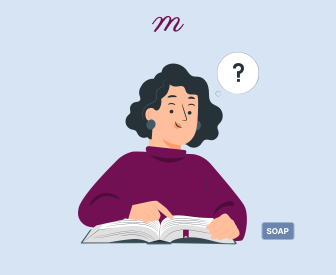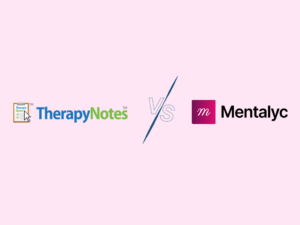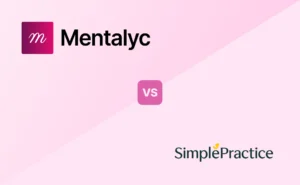SOAP note is a standardized method mental health professionals use to document and organize information gathered during client sessions. SOAP stands for Subjective, Objective, Assessment, and Plan, which are the components of this documentation method. Writing practical SOAP notes is a fundamental skill for psychotherapists. It provides a structured way to document therapy sessions. This article focuses on the "Assessment" part of SOAP notes, which is important for understanding the client's progress, making clinical judgments, and planning future therapeutic interventions.
Understanding the Assessment Section
For psychotherapists, understanding and crafting the assessment section of SOAP notes goes beyond the integration of subjective and objective data—it involves interpreting the psychological, emotional, and sometimes physiological factors influencing a client's mental health. Here are some points mental health professionals must keep in mind:
Integrate Holistic Perspectives
Psychodynamic Insights. Consider underlying psychodynamic factors such as defense mechanisms, unresolved conflicts, and family dynamics. How do these contribute to the client's current presentation?

New! Transfer your notes to EHR with a single click. No more copy-pasting.
Cognitive-Behavioral Patterns. Assess dysfunctional thought patterns, beliefs, and behaviors. Identify cognitive distortions or behavioral patterns that worsen the client's condition.
Humanistic and Existential Factors. Reflect on the client's subjective experience, including their sense of meaning, freedom, isolation, and authenticity. How do these existential factors impact their mental health?
Cultural and Social Determinants. Evaluate the influence of cultural background, socioeconomic status, and social support systems on the client's mental health. Recognize the role of systemic issues like discrimination or socioeconomic disparities.
Clinical Judgment and Differential Diagnosis
Complex Emotions and Behaviors. Psychotherapists must evaluate complex emotional states and behaviors, distinguishing between symptoms of different mental health conditions. For instance, differentiating between anxiety and depression symptoms can be subtle.
Differential Diagnosis. Consider a broad spectrum of mental health disorders, understanding that symptoms can overlap. Utilize diagnostic criteria from the DSM-5 or ICD-10, but also rely on clinical experience and intuition.
Prioritizing Therapeutic Concerns
Immediate Risks vs. Long-Term Issues. Prioritize immediate safety and risk issues, such as suicidal ideation, before addressing longer-term therapeutic goals. Avoid losing sight of the underlying problems that require attention for sustainable recovery.
Therapeutic Alliance. Consider the strength and quality of the therapeutic relationship when assessing the client's progress and challenges. The therapeutic alliance itself can be a powerful change agent.
Evidence-Based and Person-Centered Assessment
Integrate Evidence with Individuality. While grounding assessment in evidence-based practices, tailor interpretations to the unique client. Psychotherapy is as much an art as it is a science.
Feedback-Informed Treatment. Incorporate feedback from the client about their experience of therapy and its impact on them. This ongoing dialogue refines the assessment process and makes the treatment more collaborative and effective.
Reflecting on Progress and Potential
Process and Outcome Measures. Use process measures (how the therapeutic process unfolds) and outcome measures (changes in symptoms or quality of life) to inform the assessment. This dual focus can guide adjustments in the therapeutic approach.
Resilience and Strengths. Identify and amplify the client’s strengths, resilience, and resources. Highlighting positive aspects can foster a more balanced assessment and empower the client.
The Assessment Section
After writing the Subjective and Objective sections of the progress note, the mental health professional combines what they know from both sections.
The therapist identifies the primary problem and any contributing factors. They also analyze the interaction between the issues, changes, and progress. When finished, the clinician has a diagnosis of the problem, a differential diagnosis, a discussion, and a plan. Essential elements to include:
Clinical Impressions. This includes the therapist's professional judgment about the client's psychological state, diagnostic impressions, and any changes in symptoms. The therapist might note if the client's depression appears to be improving or if anxiety levels have increased since the last session.
Progress Toward Goals. The therapist evaluates the client's progress toward their therapeutic goals. This could involve noting improvements in specific behaviors, thought patterns, or emotional states, as well as any setbacks.
Therapeutic Alliance. It is vital to assess the quality of the therapeutic relationship. The therapist might reflect on whether the alliance is strong and supportive or if areas need improvement.
Risk Assessment. This includes identifying any immediate risks to the client or others, such as suicidal ideation or self-harm behaviors. The therapist must document these concerns and their impact on the treatment plan.
Cultural and Contextual Factors. The therapist considers any cultural, social, or environmental factors that affect the client's mental health. This might include issues related to identity, discrimination, or socioeconomic status.
Writing the Assessment Section
When writing the assessment section, be comprehensive yet concise. Use language that respects the client's experience and avoids pathologizing. The assessment section should lay the foundation for the therapeutic plan that aligns with the client's goals, values, and needs.
The assessment section thoughtfully synthesizes clinical data, theoretical knowledge, and human understanding. It reflects not only a diagnosis or a set of problems but a complex picture of the client in context, paving the way for a responsive and personalized treatment plan.
Here are some tips for writing an effective assessment section:
Integrate Information. Carefully combine the client's subjective information (S) and the collected objective data (O) to form a coherent assessment. This integration is critical to understanding the client's condition from multiple perspectives.
Use Clinical Judgment. Interpret the data using professional judgment, reflecting a clinical understanding of the client's current status and considering subjective and objective information.
Diagnosis and Differential Diagnosis. If applicable, include a diagnosis based on the information gathered. Also, consider differential diagnoses—other conditions that might present with similar symptoms but require different treatments.
Identify Changes. Note any changes in the client’s condition since the last session. Highlighting improvements, deteriorations, or the emergence of new symptoms can help track client progress.
Consider Biopsychosocial Factors. Incorporate an understanding of biological, psychological, and social factors influencing the client's condition. A holistic view can provide a more comprehensive assessment.
Prioritize Issues. If there are multiple concerns or diagnoses, prioritize them based on urgency, severity, or the client’s own concerns. This helps focus the treatment plan on the most critical or immediate issues.
Use Clear and Concise Language. Write clearly, professionally, and concisely. Avoid jargon that might be unclear to others reading the note. Remember, SOAP notes are often shared among healthcare providers.
Support with Evidence. Whenever possible, support the assessment with evidence or reference standards of care. This can include citing relevant guidelines, research findings, or clinical protocols that inform the evaluation.
Reflect on Treatment Effectiveness. Assess the effectiveness of any current treatments or interventions. This can inform whether to continue, adjust, or change the treatment plan.
Include the Client’s Perspective. If relevant, reflect the client's own assessment of their condition. This may include their concerns, perceived progress, or response to current treatments.
Use Evidence-Based Judgments. Base the assessment on observable behaviors, reported experiences, and evidence from the session, rather than assumptions or interpretations.
Reflect Changes Over Time. Highlight any changes in the client's condition or progress, whether positive or negative. This helps track the client's treatment journey.
Plan for the Future. Use the assessment to inform the next steps in treatment. This might involve adjusting therapeutic goals, changing interventions, or addressing new emerging issues.
The assessment section is where clinical skills and judgment are most evident. It should clearly articulate an interpretation of the client's condition and serve as a bridge to the Plan section, where the proposed course of action – based on the assessment – is outlined.
Example of Assessment in SOAP
Writing an effective Assessment section in SOAP notes requires a clear synthesis of the subjective and objective information collected during the session, alongside the therapist's clinical judgment. Here's an SOAP note example to illustrate how this might look in practice:
Subjective: The client reports feeling "a bit more hopeful" this week, attributing this change to implementing coping strategies discussed in previous sessions. They mention ongoing struggles with anxiety, particularly in social situations, but note a decreased frequency of panic attacks.
Objective: The client appeared more engaged and open during the session than previously observed. They shared a detailed account of using deep breathing techniques to manage a panic attack at work, which was a significant step forward. However, the client still shows signs of social withdrawal, opting out of a recent family gathering.
Assessment:
Clinical Impressions: The client's report of feeling "more hopeful" and the observed increase in engagement suggest a positive response to therapy, particularly in managing anxiety symptoms. The successful application of coping strategies indicates a significant improvement in self-regulation skills. However, the persistent avoidance of social situations and the client's self-reported anxiety in these contexts highlights an ongoing area of need.
Progress Toward Goals: The client has made commendable progress toward the goal of reducing panic attack frequency, as evidenced by their successful use of coping strategies. Progress toward improving social engagement remains limited. Further exploration and support in this area are warranted.
Risk Assessment: There is no current evidence of suicidal ideation or self-harm. The client's increased sense of hopefulness and proactive engagement in coping strategies reduce concerns about immediate risk.
Cultural and Contextual Factors: The client's social anxiety appears to be worsened by past experiences of bullying and a fear of judgment. These issues are compounded by their current remote work situation, which reduces opportunities for social interaction and may reinforce avoidance behaviors.
This brief example illustrates how to combine the client's subjective experiences, the therapist's objective observations, and clinical judgment to form a comprehensive assessment. It emphasizes the importance of identifying progress and ongoing challenges and adjusting the treatment plan accordingly.
Conclusion
The Assessment portion of SOAP notes pulls together a therapist's professional insights, clinical judgment, and deep understanding of psychotherapeutic principles. This segment demands a weaving of all information revealed during the session and a sense of the client's mental health trajectory. The therapist's insights transform into a coherent narrative, framing the client's experiences, struggles, and aspirations within a clinical and holistic context.
The therapist evaluates the client's condition, leveraging both the client's subjective narratives and the noted objective observations. This evaluation is not just about diagnosis. It's also about deeply understanding the client’s psychological state, life circumstances, coping mechanisms, and resilience levels. The assessment is based on evidence-based methodology, ensuring that every conclusion drawn and hypothesis made is rooted in the most current psychological research and diagnostic criteria.
The Assessment section includes the therapist's theoretical orientation and personal clinical style, which contribute to forming a tailored, dynamic treatment strategy. It acknowledges the uniqueness of each client's situation, emphasizing the need for a flexible, adaptive approach. The therapist outlines a plan that not only addresses immediate concerns and symptomatic relief but also considers long-term therapeutic goals and personal growth.
By grounding assessments in evidence, while remaining attuned to the client's individuality, therapists can create nuanced, practical treatment plans. Treatment plans evolve as new insights emerge and the client's needs and circumstances change. Through this ongoing process, therapists demonstrate their commitment to providing the highest standard of care, facilitating a transformative therapeutic journey for the client.
The Assessment section is a testament to the therapist's skill in integrating scientific knowledge with compassionate understanding, paving the way for a therapeutic path that is as informed and evidence-based as it is empathic and client-centered.
Reference:
Jacobs L. (2009). Interview with Lawrence Weed, MD, The Father of the Problem-Oriented Medical Record Looks Ahead. The Permanente Journal,13(3):84-9.
Why other mental health professionals love Mentalyc

“By the end of the day, usually by the end of the session, I have my documentation done. I have a thorough, comprehensive note … It’s just saving me hours every week.”
CDCII

“It’s so quick and easy to do notes now … I used to stay late two hours to finish my notes. Now it’s a breeze.”
Licensed Professional Counselor

“Having Mentalyc take away some of the work from me has allowed me to be more present when I’m in session with clients … it took a lot of pressure off.”
LPC

“A lot of my clients love the functionality where I can send them a summary of what we addressed during the session, and they find it very helpful and enlightening.”
Therapist






